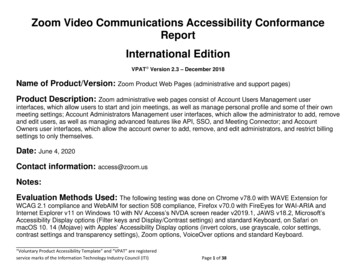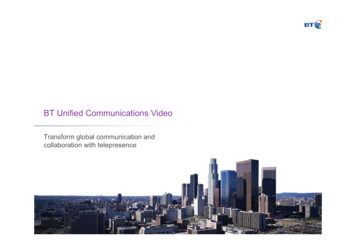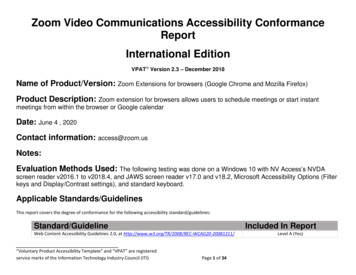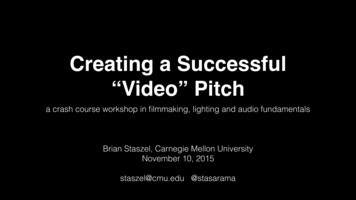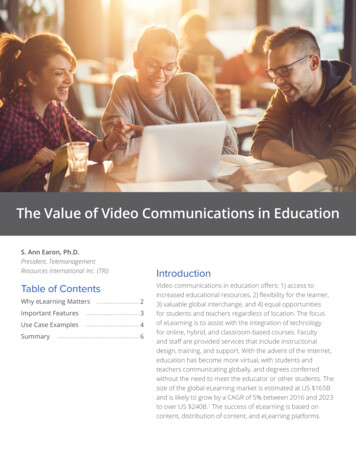
Transcription
The Value of Video Communications in EducationS. Ann Earon, Ph.D.President, TelemanagementResources International Inc. (TRI)IntroductionTable of ContentsWhy eLearning Matters2Important Features3Use Case Examples4Summary6Video communications in education offers: 1) access toincreased educational resources, 2) flexibility for the learner,3) valuable global interchange, and 4) equal opportunitiesfor students and teachers regardless of location. The focusof eLearning is to assist with the integration of technologyfor online, hybrid, and classroom-based courses. Facultyand staff are provided services that include instructionaldesign, training, and support. With the advent of the Internet,education has become more virtual, with students andteachers communicating globally, and degrees conferredwithout the need to meet the educator or other students. Thesize of the global eLearning market is estimated at US 165Band is likely to grow by a CAGR of 5% between 2016 and 2023to over US 240B.1 The success of eLearning is based oncontent, distribution of content, and eLearning platforms.
Why eLearning MattersThe value of eLearning is being recognized by moreorganizations, since it is a cost effective way to trainlarge numbers of people. It can produce significantresults by not only decreasing training costs, butalso improving performance. Students involved invideo communications are more motivated andinterested in the topic and are reported to havehigh levels of achievement in critical thinking andproblem-solving when compared to studentsphysically in the classroom.2 Schools are breakingdown the invisible walls of learning and are joininggeographically distanced learning communities,allowing students to access educators in waysnot possible before.3 eLearning can combineseveral different delivery methods, including webbased courses, collaboration software, and videoconferencing. eLearning can also mix variousevent-based activities, including face-to-faceclassrooms, self-paced learning, and live eLearningusing video conferencing. eLearning is not abouttechnology, it’s about learning, using technology.The use of video communications has the potentialto increase productivity and efficiency by reducingunproductive travel time, allowing more studentsto complete courses in a shorter period of time,reaching more students in a variety of areas, andlowering costs. By increasing access to courses,and allowing students to participate on their owntime, educational institutions can quickly see afinancial return on investment. Courses can bedeveloped once and shared with students locallyand at a distance, whether from the actual schoolwhere the course was created or by reachingothers at distant locations who have a need forthe information being delivered. Think of studentsneeding a foreign language, but not finding thecourse they need available locally. Participating at a1Elearningindustry.com, Paul Leavoy, December 23, 2016.“Interactive Cable Archives and Videoconferencing”,123HelpMe.com, 05 March 2017.distance allows these students to complete coursesas they need them from any location. There is nolonger a need to wait for a course to be available ata given site. Now students have access to a widevariety of courses from any location. This allows“We liked that on Zoom it was easy tocreate recurring meetings so studentshave just one link that works every weekand that there are minimal administrativerequirements. We also love that it iseasy to use for our students, that theyclick once and they’re in the class.”MICHAEL GRIFFINDirector of Instructional Learning TechnologyThe University of Arizonaschools to hold classes virtually even if only onestudent is available at each site. The result is betterreturn on investment since classes can be offeredmore frequently and student reach is expandedoutside the normal classroom environment.How eLearning supports the goals of education: Reduce training costsProducing learning content is time consuming,whether for online or classrooms. With eLearning,each time a course is accessed the return oninvestment improves, since the production costsare divided by the number of users. There is alsothe cost of building space, utilities, and teachersalaries to consider. Using one teacher andholding a class using video conferencing resultsin reaching students in classrooms, at distantsites, and at home for a much lower cost.2PG. 23TechZulu.com, Hitkonferencijablog.com, andHealthcarebusinesstech.com
Increase productivitySince eLearning is not bound by time orgeography, it is easier to control training’s impacton production by training people during downtimes. Given people are now being asked to domore with less, eLearning is a way to provide toolsand skills needed to enhance performance. StandardizationeLearning allows instructors to create astandardized process and consistencyin the delivery of content. It can alsocompress the delivery time by allowinginstructors to combine eLearning materialswith sessions that are facilitated. Real-time access to informationIn the past, students had to travel to a specificclassroom to take courses. With eLearning,courses can be accessed anytime, anywhere.This means students can access content from aPC or mobile device, complete the coursework,and upload their results on their own time. The use of eLearning has improvedstudent learning experiences: Graduation rates are higher becausestudents can take courses on theirown time from any location.4Student athletes, who often have4Online Education Supports Improved Time to GraduationRates, Victoria Brown, Florida Atlantic University, 2016.PG. 3 People who commute to attend coursescan now get their education online. Special needs students have access tocourses without the need to travel.In a recent survey, conducted by TechValidate,educators and administrators in collegesand universities were interviewed. Thesurvey data indicated the following: 88% believe video conferencing will allowmore people to complete advanced degrees. 73% believe video conferencing willreduce student dropout rates. 87% plan to increase investment in onlinecollaboration tools in the next 5 years.The respondents identified the top 3 usecases for video collaboration in education.1.Collaboration with othereducation professionals,2.Expand reach across geographies, and3.Ability to have a guest lecturer join virtually.Ongoing Access to ResourcesWhen classes are taken on site, during a specifictime period, students must be in attendance or getnotes from other students. If a refresher courseis needed, students must sign up for anothercourse. With eLearning, students can accessonline content and review it as needed. Studentslearn on their own time at their own pace. difficulty completing courses dueto athletic schedules, are now ableto learn on their own time.Important FeaturesWhen thinking about using eLearning videocommunications in education, there areimportant features to consider that makethe experience easier and more rewardingfor the teacher and the students.Two-Way Video and AudioIn the past, many eLearning courses have beentaught with just audio and a slide deck. Two-wayinteraction is crucial for increasing engagementbetween remote and local students and professors,and leveling the playing field between students.
Video Breakout RoomsVideo breakout rooms allow people tocreate smaller teams to collaborate with andlearn from one another, all within the samemeeting or training session. This replicatesthe common in-person pedagogical practiceof breaking the class into small groups.Video WebinarCreate online events that include registration,reporting, Q&A, and polling. Video webinarsare a valuable tool for admissions, alumniengagement, orientation, MOOC (Massive OpenOnline Courses), and other large-scale events.IntegrationLTI (Learning Tools Interoperability) makes it easyto schedule a meeting with any course activityand invite the right students from your learningmanagement system (LMS). Common LMSsystems include Blackboard, Moodle, Canvas, andDesire2Learn. This integration makes it easierto learn regardless of platform used, insteadof downloading different software packagesto be compatible to what others are using.AccessibilityAccessibility features enable users withdisabilities to schedule, attend, and participatein meetings and webinars. This is a legalrequirement for universities and should bea key component of any eLearning tool.RecordingRecord any session for students to watch at alater date, at a time convenient for them.It is important to find an eLearning tool thatuses standard file formats that are easy to editand share, such as MP4 and M4A formats.Sending FilesThe Grouping Messaging features allowPG. 4participants to send text, images/files or audiofiles to a contact or to a group. Students canuse this for team projects and study groups,and professors can make a new group withtheir students for each course or section.Simplicity/Ease of UseConnecting to a video call should be easy.Participants should be able to join fromtheir consumer devices with minimal clicksand no special codes to input. Ideally, itshould integrate with existing calendaringsystems and single-sign on (SSO) providersto maximize convenience and security.“Zoom has allowed online learning programsto be more successfully deployed whencompared to competing products. Thevideo quality of Zoom allows all remoteparticipants to better see the faces of theirclassmates while easily integrating contentsharing, breakouts, and annotation.”TIM O’NEILIT Director Brandeis UniversityStudents and professors should be able tojoin from any device – mobile, desktop, orconference room. The mobile experience shouldbe seamless with true mobile screen-sharing,mobile start/join, and mobile scheduling.Classroom SupportMany classrooms are either not video-enabled,or are equipped with traditional H.323 orSIP conference room systems. It’s vital thatphysical classrooms are brought into virtualenvironments for true hybrid in-person/virtuallearning experiences. The eLearning solution
should support the development of softwarebased video-enabled classrooms that runaffordable off-the-shelf hardware. It shouldalso support H.323/SIP systems so that theseinvestments can continue to be utilized.Use Case ExamplesDistance Learning & Hybrid LearningHybrid and distance learning programs and coursesstrengthen academic values in the following ways: Continue to facilitate academic excellenceamong students, faculty and staff, Extend quality educational opportunities tomembers of the community who are unableto attend traditional, on-campus courses, Provides flexible learning environmentsfor working professionals, and Integrates technology, timemanagement, and life-long learningskills into the curriculum.5Fischler School at Nova Southeastern Universitywas sending representatives into the field to visiteach student in his/her clinical placement atleast three times during his/her program. Theserepresentatives include faculty members and alumniof the program located in various areas of thecountry. As the number of students in the programexceeded 800 the review process became morechallenging. Zoom’s simple, affordable solutionperfectly suited these needs. Instead of wasting timetraveling, specialists can work more efficiently byjust launching a Zoom meeting on their computeror mobile device to check in with a student.Guest LectureSchools are using video conferencing to accessguest speakers from anywhere in the world toshare their powerful stories with students whowould not have access to these guess lecturersany other way. Topics are brought to life by peoplePG. 5with expertise willing to share their knowledge.Using video conferencing to connect studentsto more experts is useful in more ways than justaltering the daily routine. Students are moremotivated to learn and work on their studieswhen they can see the actual connection betweenwhat they are learning and the real world. Usingvideo conferencing to bring more experts into theclassroom can help motivate students by lettingthem discuss the real-world applications of theirwork with people who actually use that knowledge.The Center for Interactive Learning and Collaboration(CILC) started out as a state-based organizationconnecting schools with other schools, museums andzoos in Indiana via video conferencing. EventuallyCILC connected schools across the nation withother national and international cultural andeducational organizations. CILC decided that Zoomis the best fit for an environment where seamlesslearning and presentations can and must takeplace. What sets Zoom apart from other solutionsis that it’s a one-click-and-you’re-in solution.Virtual Office HoursVideo conferencing is now being utilizedfor virtual office hours. The need to be in aphysical office no longer exists with the use oftechnology. Now students can meet with teachersvirtually to ask questions, discuss a project, andobtain immediate responses any time. Videoconferencing gives everyone the flexibility toschedule the amount of time needed to meet,thus using everyone’s time more efficiently.Since video conferencing is now as simple asmaking a phone call, virtual office hours can beset up instantly allowing teachers and studentsto meet on a more regular basis or as neededto respond to a question or solve a problem.Stanford Continuing Studies offers over 100 courses,workshops, and specific events on topics rangingfrom liberal arts and sciences, to creative writing,5Student Guide to Hybrid and Distance Learning,South College, Knoxville, TN, 2011
and professional and personal development. Thecourses are taught to over 13,000 students eachyear, with 8% of these students taking onlinecourses. Malena Wantrous, Lead Instructor, usesZoom for virtual office hours. The “door is open”two hours a week. She appreciates that Zoom isunobtrusive; she can go about her work and forgetit’s on until a student enters the Zoom session.Research Collaboration Among InstitutionsResearch collaboration is people working togetherto solve a problem, create a product, or derivemeaning from a body of material. With theadvent of video communications technologies,research collaboration among institutions is nowbecoming a reality. Geographically dispersedresearch and education groups are relyingon video communications to achieve theirgoals of collaboration between educators.Though much has changed in higher education,networking and collaboration are moreimportant than ever for bringing people andideas together. Collaboration is also importanton the global stage. Globalization is a realityand collaboration amongst internationalinstitutions is a way to learn from other culturesand researchers. Research is being conductedacross universities, time zones and countries.Mount Holyoke developed a program to connectteachers to the college without needing to putthese teacher-students through the expense oftravel and accommodations. They tore down thebarriers that forced teachers to restrict themselvesin the four walls of the classroom. They use Zoomto connect teachers across the nation using asolution that allowed them to collaborate andreally meet in a way that was similar to in-personmeetings. With Zoom they are able to have teachersaround the world use the software to interactin real time with Mount Holyoke classrooms.SummaryVideo communications allow educational institutionsto expand their impact across geographies to reachmore students and offer new learning opportunitiesfrom guest lecturers, to research amonginstitutions, to reaching students off campus.Regardless of whether it is known as eLearning ordistance learning, the use of video communicationsincreases productivity, reduces training costs, allowsaccess to subject matter experts (regardless oflocation), and offers students real-time, immediateaccess to classes and course materials.The combination of multimedia and instructionaldesign, coupled with practice activities andfeedback, results in a learning environment thathelps students retain course content. Learnerswant control of their time and eLearning gives themthe opportunity to learn from anywhere at any time.To remain competitive and increase revenue,educational institutions need to use videocommunications to reach existing and newstudents, provide access to outside experts,collaborate with other institutions, and virtuallycommunicate with students, faculty and staff.About S. Ann Earon, Ph.D.S. Ann Earon has been a researcher and consultantin conferencing and collaborative communicationsfor 35 years. She holds a Masters in instructionaltechnology and educational administrationfrom Northeastern University, and holds aninterdisciplinary Ph.D. from Boston College withmajors in business, speech & communications, andeducation. Dr. Earon is the Founding Chairpersonof IMCCA, the non-profit industry association forconferencing and collaborative communications.She can be reached at AnnEaron@aol.com.PG. 6
for online, hybrid, and classroom-based courses. Faculty and staff are provided services that include instructional design, training, and support. With the advent of the Internet, education has become more virtual, with students and teachers communicating globally, and degrees conferred wit

